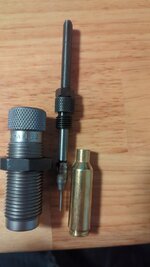Most of my dies for guns that I shoot a lot use match grade seaters and bushing dies. No complaints with them. But for a handful of the rounds that I don’t shoot as much I just use some standard RCBS and Redding regular FL sizing and standard seating dies. I definitely notice better concentricity out of the better quality dies. I don’t want to replace the standard dies I have.
Are there any set up or usage tweaks to get better results out of standard dies? I’ve always questioned how well the seating die really straightens out that bullet when just set in the case mouth with my fingers. And obviously the neck is seriously getting worked over during sizing. Can anything be done to minimize the negative effects?
At the bullet I tend to get .004-.006” deviation and higher ES with standard dies versus .001-.003 with match dies.
Are there any set up or usage tweaks to get better results out of standard dies? I’ve always questioned how well the seating die really straightens out that bullet when just set in the case mouth with my fingers. And obviously the neck is seriously getting worked over during sizing. Can anything be done to minimize the negative effects?
At the bullet I tend to get .004-.006” deviation and higher ES with standard dies versus .001-.003 with match dies.
Last edited:

